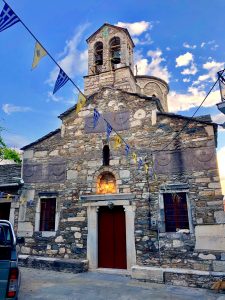
Agios Michael Synadon… a Greek Orthodox Church among the whitewashed houses and shops of Skopelos. The three largest stones on the front date from the Roman era and are fragments of sarcophagi (stone coffins). Agios Michael Synadon
We weren’t inside this little church for more than twenty minutes, but that was long enough to be reminded yet again of my ignorance on… well, so many things. Architecture and Greek Orthodoxy are topics that come to mind, as well as the history of the 100+ public and private churches that exist in Skopelos, the little Greek town we’re residing in while my husband completes an artist residency.
We discovered one of those churches, the Church of Agios Michael Synadon, on our second night on Skopelos Island northeast of mainland Greece. The church is tightly wedged into a small neighborhood and you can easily pass right by it if you’re talking or, like my husband Mitch and me, concentrating on the steep walk down from the top of the hill to the harbor-front shops and restaurants of Skopelos Town.
As you walk by, following the well-marked path from the hilltop, you pass the backside of the church. The apse first caught Mitch’s eye and caused us to stop and wander around the corner to the front of the church.

It’s easy to overlook Agios Michael Synadon unless you notice the curved apse jutting out into the stone path.
In fact, according to this Skopelos News blog, another detail that makes the church so notable is the stele placed just below the apse window (see the light-colored stone directly below the dark window in the picture above). A stele is a piece from an old Greek grave that dates from the second century B.C. Steles may feature carvings such as flowers and inscribed names, as this one does.
Another detail worth noting, according to Skopelos News, are five large gray stones, remnants from Roman-era sarcophagi (coffins). There are three on the front side of the church and two on the back. They are the largest stones that you see in the pictures above.
The main front doors of the church were locked, but a door off to the side was not. We knocked and walked inside to meet a woman with shoulder-length brunette hair and dark brown eyes.
“Καλησπέρα,” the woman said, Greek for “good evening.”
“Kali-spera,” we replied and followed her into the nave, the main sanctuary. Inside, it was musty and dark, lit only by a box of candles burning on a table near the front.
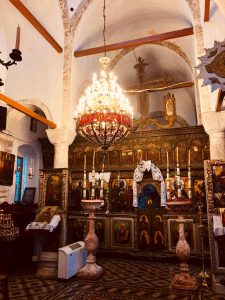
Agios Michael Synadon was nearly dark until the woman attendant turned on this chandelier.
“You are Greek Orthodox?” the woman asked us quietly, hesitating in her choice of English words.
“No,” I replied, wondering if that would affect our visit.
She continued, “You are from where?”
“United States,” I replied. She nodded and smiled, and walked to the wall to turn on the lights. The chandelier hanging above us glowed brilliantly, illuminating the entire room filled with icons, paintings, frescoes and artwork, carved chairs and other furniture.
We walked to the front to view the icons there. Finely applied oil paints revealed brilliant cheekbones and almond-shaped eyes, typical for post-Byzantine era portraits. Several had pierced silver elements attached to the paintings, in effect creating mixed media icon artworks.
I stood below and to the side of the chandelier and gazed up at the fresco-painted dome and then around me. There was simply too much, too many details to absorb. I didn’t even think to ask when the church was built.
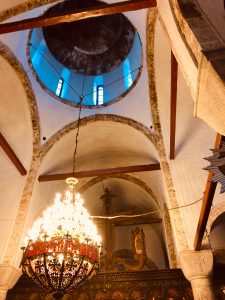
The fresco in the dome is difficult to discern due to age and years of exposure to candle smoke.
I still haven’t been able to determine how old the church is, but it does resemble another church in style and materials that we stumbled upon in Skopelos known as Panagia Eleftherotria. According to Skopelos News, archaeologist Adamatios Sampson claims Panagia Eleftherotria was originally built in the 16th century.
Wanting a photo, I asked the woman if I might take one. She smiled and sighed and I wondered if I had overstepped. Surely I wasn’t the first tourist wanting to capture the beauty of this small place. But then she nodded and I took two pictures on my iPhone, taking care to silence it to avoid that annoying click.
We then thanked the woman and the three of us walked back to where we had entered. On the white plaster walls of this side room thirty to forty small paintings, miniature icons, hung from two wires. The woman searched for the English words that suggested these paintings were created by her students. She showed us some larger paintings also tucked behind the smaller ones, which I believe she said she had painted. One Virgin Mary rendition measured approximately 24″ x 30″.
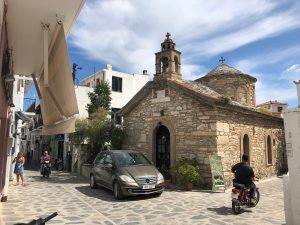
Here’s another church we stumbled upon in Skopelos known as Panagia Eleftherotria. It appears Agios Michael was built around the same time, the 16th century.
I asked her if the artwork was for sale, since the manner in which they were displayed indicated that they might be. She shook her head, and then I remembered that buying and selling wouldn’t be appropriate in a place of worship. She motioned with her hand to her side and said, “Shops,” indicating perhaps that her work was available elsewhere in town.
Finally, we asked where we could leave a donation. She led Mitch back into the sanctuary, where he placed a €5 into a brass offering box near the front of the nave. We then exited the Church of Agios Michael Synadon.
Outside, we took another few minutes to study the exterior, which was covered with a mixture of bricks, marble stones, the large sarcophagi, plus an assortment of porcelain dinner and serving plates inset as accents into the facade.
In the short span of twenty minutes at the church, there was just too much to see and honestly, I felt like an intruder… an outsider very ignorant of the traditions and rituals that this little building upholds. Maybe that’s the most valuable lesson that traveling to new places teaches us: how much we don’t know.
As we left, the woman called to my husband from the doorway of the side entrance. He walked back to her and then returned with a souvenir for each of us: a small color printout of her Virgin Mary painting.
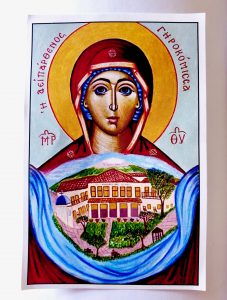
The color printout of our guide’s artwork.



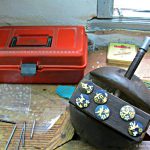

Great article, Marilyn. We enjoyed it a lot along with your fantastic photos. We’ve been to Athens maybe 4 times during our world travels – also, to several Isands like Patos & Santorini. Yep, the Greek Architecture and Greek Orthodoxy are right up our alley. Thanks for all the Skopelos info. It’s much appreciated.
M&G
NYC – USA
Very nice writing and intriguing place, Marilyn. I hope to make it to Greece. Thanks!
100-plus churches in this little town. Do I have that right? That’s the very definition of a church-going community. God bless ’em! (And good job on the article.)